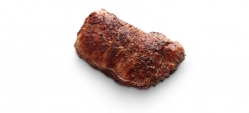

Highly marbled cuts like a grain-finished Prime-grade ribeye and strip should be cooked a few degrees Fahrenheit higher than leaner steaks like tenderloin, since their copious intramuscular fat helps keep them moist while delivering plenty of flavor. I prefer ribeyes and strip steaks cooked medium-rare to medium, around 129°F / 54°C to 135°F / 57°C. Fattier steaks also have natural insulation which means they'll take slightly longer to reach the correct internal temperature.
Timings are all given for steaks one-and-a-half to two inches thick. For steaks one inch or less, initial cooking time can be shortened to 40 minutes. Steaks cooked under 130°F / 54.4°C should not be cooked longer than two-and-a-half hours at a time for food safety reasons.
Very Rare to Rare: 120°F / 49°C to 128°F / 53°C;1 to 2 1/2 hours
Medium-rare: 129°F / 54°C to 134°F / 57°C;1 to 4 hours*
Medium: 135°F / 57°C to 144°F / 62°C;1 to 4 hours
Medium-well: 145°F / 63°C to 155°F / 68°C; 1 to 3 1/2 hours
Well done: 156°F / 69°C and up; 1 to 3 hours
*2 1/2 hours max if under 130°F / 54°C
J. Kenji López-Alt
J. Kenji López-Alt is the Managing Culinary Director of Serious Eats, author of the James Beard Award-nominated column The Food Lab, and a columnist for Cooking Light. He lives in San Francisco. A New York native, Kenji cut his cooking chops the old-fashioned way by working his way up through the ranks of some of Boston's finest restaurants. With an education in science and engineering and as a former Senior Editor at Cook's Illustrated and America's Test Kitchen, Kenji is fascinated by the ways in which understanding the science of every day cooking can help improve even simple foods. He earned a James Beard award for his first book, The Food Lab: Better Home Cooking Through Science, which he released in September 2016. It is available for purchase from Amazon and Barnes & Noble.